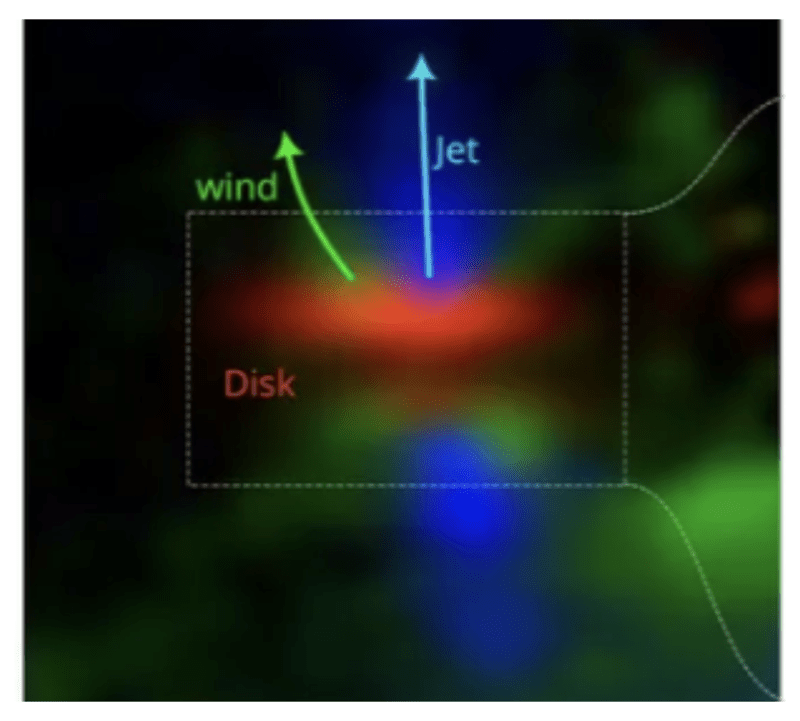GS Paper III
News Excerpt:
Astronomers have used the James Webb Space Telescope (JWST) to paint a picture of burger-shaped, planet-forming material around a young star.
What is Space ‘Hamburger’?
Researchers have used the James Webb Space Telescope (JWST) to click a space 'hamburger'. In layman's terms, this is the very first ice map of a protoplanetary disc around a young star.
Protoplanetary Disc: A protoplanetary disk is a rotating circumstellar disk of dense gas surrounding a young newly formed star.
- When our solar system formed, the Sun was the first to form out of clumps of gaseous clouds that came together, collapsed under their gravity and eventually kickstarted nuclear fusion as more and more material 'fell' into the still-forming Sun. After the Sun was formed, the remaining material was still revolving around it. This 'protoplanetary' disc eventually gave rise to planets.
How is Ice Mapping done?
As the star passed through the protoplanetary disc, its light was filtered through the dust, ice and other materials containing a variety of elements. Now each element absorbs and emits light in a specific way, giving rise to somewhat of a 'signature' of that element. By observing the spectrum, a picture can be 'painted' about what elements might be present in whatever the light is passing through.
- The star and its discs are located about 600 light-years away from us in the direction of the Chameleon constellation.

-
- The disc itself looks like a hamburger with a dark central lane and two bright “buns.” This is because we are looking at it from the side.
- The researchers used the Webb telescope to study the starlight from the relatively young star HH 48 NE as it passed through its planet-forming disc.
- This creates an absorption spectra with different peaks specific to each molecule. As starlight from HH 48 NE passes, it interacts with molecules in the disk and is absorbed. Because elements and molecules absorb and emit light at characteristic frequencies, that means they leave their fingerprints on the starlight itself when it reaches the JWST.
-
- In the light from this young star, the astronomers could see the fingerprints of ammonia, cyanate, carbonyl sulfide and heavy carbon dioxide, all in the form of ice.
- One outcome of this particular aspect of the research is the discovery that carbon monoxide ice in the protoplanetary disk may be mixed with less volatile carbon dioxide and water.
Why Ice Mapping is important for any planet?
- Ice is essential in the formation of planets and comets. Ice allows solid dust grains in protoplanetary disks to clump together, forming chunks of material that can gather mass and eventually become planets.
- Solid dust particles clump together into larger chunks because of ice. This is what forms planets and comets.
- Also, scientists believe that impacts from icy comets play an important role in contributing to the amount of water on our planet.
- Ice may also contain atoms of carbon, hydrogen, oxygen and nitrogen, which are considered to be the building blocks of life.
About James Web Telescope: The James Webb Space Telescope is the world's premier space science observatory. Webb will solve mysteries in our solar system. Webb is an international program led by NASA with its partners, ESA (European Space Agency) and CSA (Canadian Space Agency).
Way Forward:
- One outcome of this particular aspect of the research is the discovery that carbon monoxide ice in the protoplanetary disk may be mixed with less volatile carbon dioxide and water, something that would allow it to stay frozen at closer proximities to the young star than has previously been estimated. That means planets with high carbon content could form near their stars.
- The direct mapping of ice in a planet-forming disc provides critical input for modelling studies that aid in better understanding the formation of our Earth, other planets in our Solar System, and planets orbiting other stars. With these findings, scientists can now make more definitive conclusions regarding the physics and chemistry of star and planet formation.


